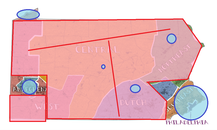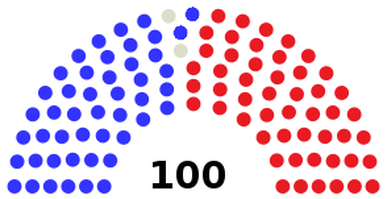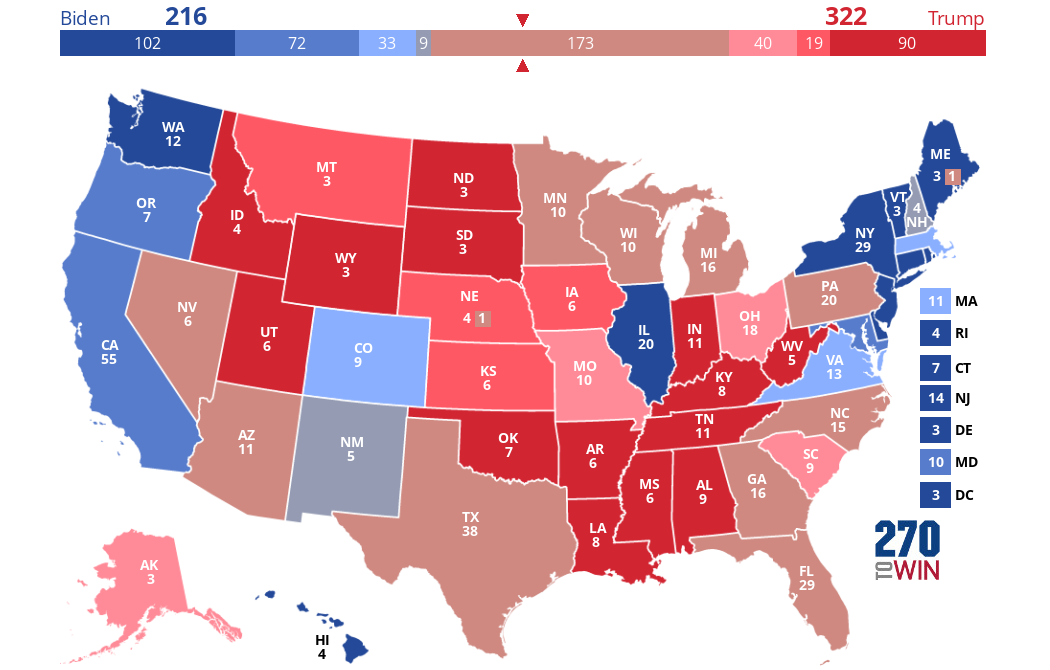Nathan Bryant’s Election Predictor

I am not a polling professional, but I have had experience doing it in the past for varying candidates. I have worked for three U.S. Senators and worked on a Gubernatorial campaign. Most recently I have been doing more local elections work and volunteering behind the scenes. As a right-leaning Independent I of course have my opinions on this election, but I have tried to keep my biases in check as I analyze my perception of the electorate this year.
After researching the polls, (both how they were put together, and by what type of voter was asked), analyzing early voting data, and looking at new voter registration numbers. I am predicting President Trump will win a second term, but it will be awfully close.
Below are my maps, using 270ToWin.com’s interface I have created a map that I will edit as well as my final prediction on Monday evening.
I will be updating my predictions all the way through until a winner is declared. I will also be providing my own analysis as to why I am picking certain states to turn red and blue, even if polling figures are saying otherwise.
After researching the polls, (both how they were put together, and by what type of voter was asked), analyzing early voting data, and looking at new voter registration numbers. I am predicting President Trump will win a second term, but it will be awfully close.
Below are my maps, using 270ToWin.com’s interface I have created a map that I will edit as well as my final prediction on Monday evening.
I will be updating my predictions all the way through until a winner is declared. I will also be providing my own analysis as to why I am picking certain states to turn red and blue, even if polling figures are saying otherwise.
Interactive map:

You will see that I have President Trump winning by a large margin in the Electoral College. I think he will carry more states as a whole than he did previously in 2016, but barely winning many of them. This is attributed to his fired up base and the GOP-led voter turnout and voter registration drives which surpassed the effort put in by Democrats in the months leading up to the election.
TRUMP'S Many Paths to victory:
It is no surprise that Biden will do incredibly well in the Northeast and the Pacific states. His hold on those densely populated areas will allow him to break the 150 EC delegate barrier easily and quickly. As long as the Northeast states have no issues which will delay reporting, he will take a huge early lead on election night. As the South and Midwest come in however, he will stagnate. Biden will lose Maine’s 2nd district which tends to run more independently than the rest of the state, but he will hold on to win New Hampshire (a very tricky state to poll given it’s very independent and *disloyal voters). Though Biden had a pathetic showing there in the democratic primaries, enough time has passed for him to unite his party there just enough to pull out a win. His people will come out to vote, but not enthusiastically.
All of this is assuming my picks of Texas, Florida/North Carolina, and Ohio all safely in Trump's column. All are states that he won easily in 2016 and have had major Republican victories since. As long as those states stand as I predict they will... this is Trump's to lose. if Biden steals one of them... all of this could flip in a split second.
BIDEN’S Most Probable Path to victory:
*I mean this term not disrespectfully, but practically. New Hampshire party voters historically do not necessarily coalesce around their party nominee if it wasn’t who they chose in the primary season. With that, independent voters typically feel no loyalty towards the party of their first choice candidates, but can be swayed by policy and debate towards the other side rather easily. I love that the people of New Hampshire take their role so seriously to vet candidates and I think they secretly love being such an anomaly for polling outlets.
TRUMP'S Many Paths to victory:
- 2016 was historic, not only because of the out-of-nowhere nature of Trump's win, but the way in which he did it. He broke through the Blue wall/Rust-belt that Democrats had seemed to hold at least part of since Reagan. The question now remains, was that a fluke? Or does Trump's brand of Conservative, Working Class First policies resonate with these states in a new way? I see no indication to suggest that the same people who came out for him in 2016 won't return in 2020.
- Amongst the few changes we may see in the electorate and how they fall I think the voters who are loyal to Trump will outweigh any losses he may have from those who just voted "against Hillary" or who take issue with Trump's CoVid responses. Here's the breakdown:
- I predict that Trump will see his support among “Evangelical” voters rise, while even more mainline Protestants who have been turned off by his brand of politicking will bend towards Biden. This will be inconsequential as he will rally the conservative Catholic vote and many who are considered non-Christian religious groups.
- He also will rally enough of the industrial union workers, along with farmers, and new manufacturing, textiles, and oil workers (that may or may not be unionized, therefore missed by much polling) to squeak out some surprising victories. Any lag that Trump seems to have amongst Seniors will also be overshadowed with his support from middle class workers
- I have many of the rust-belt states holding strong for Trump, and Minnesota actually flipping for him even with the possible loss of some union support. This is because of an up-tick in support from minority workers and industrial/trade workers who are coming out as first time voters for the President due to his Trade policies.
It is no surprise that Biden will do incredibly well in the Northeast and the Pacific states. His hold on those densely populated areas will allow him to break the 150 EC delegate barrier easily and quickly. As long as the Northeast states have no issues which will delay reporting, he will take a huge early lead on election night. As the South and Midwest come in however, he will stagnate. Biden will lose Maine’s 2nd district which tends to run more independently than the rest of the state, but he will hold on to win New Hampshire (a very tricky state to poll given it’s very independent and *disloyal voters). Though Biden had a pathetic showing there in the democratic primaries, enough time has passed for him to unite his party there just enough to pull out a win. His people will come out to vote, but not enthusiastically.
- Trump will hold the South and the "Fly-over states". This will give him a considerable advantage while waiting for some of the other close ones to finalize their tallies. Although it will be incredibly close, I think he will pull out a solid win with the Electoral College even if he once again loses the popular vote. Trump can afford to lose two of these states and still win, no matter how some of the smaller states go. As long as he holds Arizona or steals one of the "Hillary" state from Joe, Trump can actually afford to lose THREE of these swing states and still win another term. Biden has to run the gauntlet in this scenario to keep it close.
All of this is assuming my picks of Texas, Florida/North Carolina, and Ohio all safely in Trump's column. All are states that he won easily in 2016 and have had major Republican victories since. As long as those states stand as I predict they will... this is Trump's to lose. if Biden steals one of them... all of this could flip in a split second.
BIDEN’S Most Probable Path to victory:
- Joe Biden will need to steal Pennsylvania. To me that seems like the whole ball game. Biden must win Pennsylvania and one other rust-belt state.
- This is totally do-able. Biden was born in Scranton and has spent time there in the recent weeks, while also trying to stir up his support in the very blue Philadelphia area. If Biden gets voters to turn out for him in those two areas, and has any type of showing in the surrounding Pittsburgh/Harrisburg areas... Trump's turnout in the "T" region will need to be HUUUUGE to overcome it. My thinking in why I still have this bending towards Trump is that Biden doesn't have the energy to turn out the numbers he will need in those city areas.
- I think Biden will need to take another chunk from Trump's 2016 Red Wall in order for him to have a formidable path to victory. Again, totally doable. The polls are close in all of those states. Many polls actually have Biden leading. I just don't think their formula is accurate. These rust belt states have gone to the democrat (other than Ohio) every time since 1992 with the one exception: Donald Trump in 2016. I predict Trump will hold his wall... albeit barely for the same reason he will hold Pennsylvania.
- I also believe he will need to take away from Trump’s hold on the Southeast by winning either Florida or North Carolina.
- Florida has increasingly become a red state in the last 40 years. It hasn’t elected a Democrat to the office of Governor since 1994. Barack Obama won it twice (barely), Bill Clinton won it in 1996 in his re-election bid, but it was solid red throughout the Reagan-Bush and W. Bush eras. It is doable... but the things Barack and Bill had going for them were youth, vigor, and charisma... not exactly Joe’s strengths. Demographics change, voters concerns change, we shall see what happens. Personally I think this is going to be a stretch for him to do though. This is considered Trump’s home state now and his support in the I4 corridor and Panhandle seem strong enough to withstand any surge from Miami-Dade and Tampa areas.
- North Carolina is going to be even tougher for him if history is an indicator:
- Since 1968, North Carolina has turned blue in a Presidential race only twice. When their Senator John Edwards was the VP for John Kerry’s 2004 campaign? Nope. When popular VP and former neighboring Senator Al Gore was running? Nope. How about when Obama was running against the rich white business guy Romney? Nope.
- NC went blue in 2008 to elect the first African-American president against McCain who was seen as too much like President Bush and the spirit of change was in the air, and when neighboring Georgia’s Governor Jimmy Carter ran against the un-elected, disliked President Ford in 1976. It is important to note that NC flipped back to Red in 2012, against the Obama-Biden ticket.
- One thing going for Biden is that his name was on the ballot when Obama flipped it blue in 2008. Is there enough warm fuzzy nostalgia to push him over the top in 2020? I doubt it.
- The one constant variable in this entire election is both the greatest draw and the greatest vice for Trump’s re-election hopes...and that is Trump himself.
*I mean this term not disrespectfully, but practically. New Hampshire party voters historically do not necessarily coalesce around their party nominee if it wasn’t who they chose in the primary season. With that, independent voters typically feel no loyalty towards the party of their first choice candidates, but can be swayed by policy and debate towards the other side rather easily. I love that the people of New Hampshire take their role so seriously to vet candidates and I think they secretly love being such an anomaly for polling outlets.
Final Prediction:
Last edited: 11/2 9 PM
U.S. Senate

The GOP currently has a 53 member majority. They may lose Susan Collins in Maine. However, I believe Alabama will be flipping the seat currently occupied by Doug Jones. So that will be a wash. We will not know the outcome of Georgia's one Senate seat as I don't predict any candidate will surpass the 50% threshold needed, therefore we will need to wait for that run-off. I predict every other incumbent will hold on and win their re-election bid. This means that the Georgia race could be the determining factor for the entire balance of power. If Warnock beats Loeffler in Georgia, the Democrats may take control of the Senate simply by influencing the Independent Senator King from Maine who usually caucuses with them.
Otherwise, the balance of power in the Senate will be determined by who is elected Vice President.
One dark horse I would watch out for is in Michigan with John James. If Trump carries Michigan, his coattails could swing in a wave of support for James. That would be a crushing blow to the Democrats hopes of taking the Senate. This is a long shot though. I do have Trump winning Michigan, but by such a slim margin that I do not think his influence will be enough to put James over the top.
Otherwise, the balance of power in the Senate will be determined by who is elected Vice President.
One dark horse I would watch out for is in Michigan with John James. If Trump carries Michigan, his coattails could swing in a wave of support for James. That would be a crushing blow to the Democrats hopes of taking the Senate. This is a long shot though. I do have Trump winning Michigan, but by such a slim margin that I do not think his influence will be enough to put James over the top.
U.S. House
I'm not even going to try to figure this one out. The bottom line here is that Congressional districts are almost impossible to poll accurately. It all depends on the answer to two crucial questions in regards to the coat tails of the winner of the Presidency... 1.) did those voters come out in droves? and 2.) did they vote down ballot?
Most polls suggest that the Democrats maintain their majority here, maybe with a few in-roads by the GOP, but depending on how turnout goes... these could be perfectly accurate or horribly wrong.
Most polls suggest that the Democrats maintain their majority here, maybe with a few in-roads by the GOP, but depending on how turnout goes... these could be perfectly accurate or horribly wrong.


 Click the map to create your own at
Click the map to create your own at 
